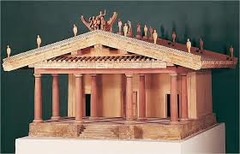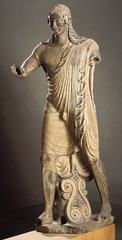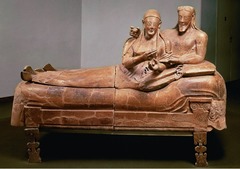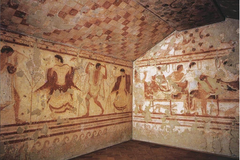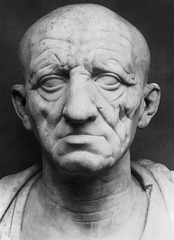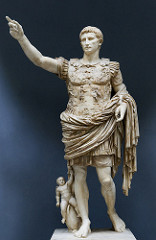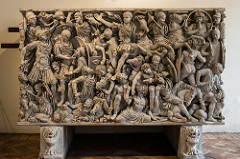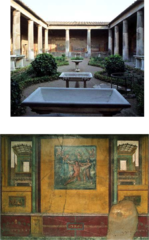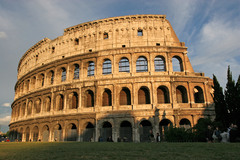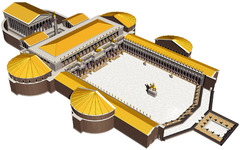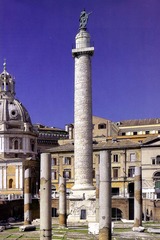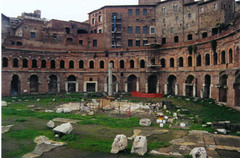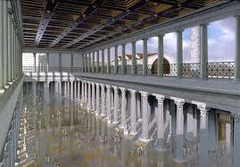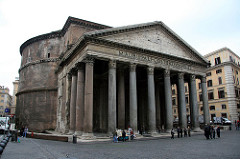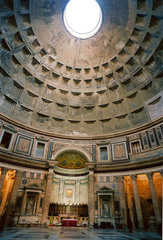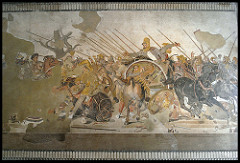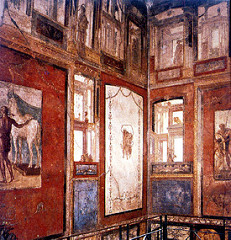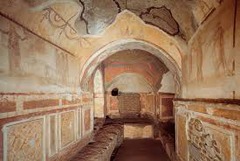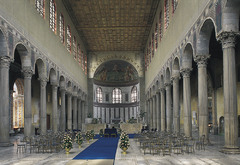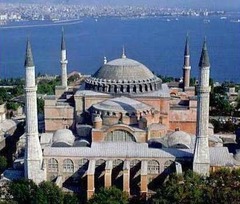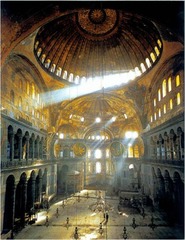Temple of Minerva - 510 BCE
Period: Rome, Etruscan
Function: worship
Material: mud & wood
-sculpture on roof, not in pediment
-steps & columns are only in front
-cella = 3 rooms w/a door each, goes to edges of stylobate
-mixture of doric/ionic = tuscan
Temple of Minerva, Apollo - 510 BCE
Period: Rome, Etruscan
Material: terra cotta additive method, hollow
Function: worship
-clothed, not stiff pose
-face is exaggerated
-about same time as Anavysos Kouros
Sarcophagus of the Spouses - 520 BCE
Period: Rome, Etruscan
Material: hollow terra cotta
Function: storage for ashes in tombs
Context: man & woman = gender equality
-twisted body form/poses
Tomb of Triclinium - 480 BCE
Period: Rome, Etruscan
Material: fresco (plaster/paint)
Function: commemorate death celebration
Context: used in necropolis room
-shows both man & woman = gender equality
-skin tone denotes gender (women = light, men = dark)
-not realistic, very 2D
Head of a Roman Patrician - 75 BCE
Period: Rome, Republic
Function: portrait of family/ancestor, bring to parties
Patron: family
Material: stone
Context: old is good (senator) = veristic style
-emphasize old age
-bodies don't matter (young/buff)
Augustus of Prima Porta - 20 BCE
Period: Rome, Early Empire
Context: Pax Romana
Material: marble- used to reflect Greeks
Function: portrait of Augustus, propaganda (Greek)
-Augustus- depicts himself as different professions
-moves away from veristic, stays youthful in sculpture
-armored/clothed as general (contrast Greek)
-contrappasto
-has cupid- descent from Venus
Ludovisi Battle Sarcophagus - 250 CE
Period: Rome, Late Empire
Function: holds dead body
Material: marble
Context: late empire troubles, religious conflict
Patron: someone of Persian religion (X on forehead)
-depicts chaotic battle (romans/goths)
-relief sculpture but very 3D
-no organization, depth, space = distant from Greek influence (late antique style)
House of Vetii - 200 BCE/70 CE
Period: Rome, Early Empire
Context: very well preserved in Pompeii
Function: fairly high-class house
Material: concrete, fresco
-has all 4 styles of painting
-fresco paintings well preserved
-has yard w/peristyle & statues
Colosseum - 70-80 CE
Period: Rome, Early Empire
Material: concrete
Function: theater- gladiators (blood sports)
Patron: Vespasian (emperor after Nero)
Context: Vespasian wants good reputation (public opinion)
-stacked barred vaults (3 layers), columns between each- bottom = tuscan, middle = ionic, top = corinthian
Forum of Trajan - 106-112 CE
Period: Rome, High Empire
Material: marble/bronze
Function: commemorate Trajan, city center
Context: use of art as propaganda
Patron: Trajan
Column of Trajan - 106-112 CE
Period: Rome, High Empire
Function: commemorate Trajan, public opinion; tomb
Material: marble
Context: use of art as propaganda
Patron: Trajan
-125-foot tall, hollow w/stairs
-was a sculpture of Trajan of bronze
-register wraps around column (military victories)
Market of Trajan - 106-112 CE
Period: Rome, High Empire
Function: 170 stores+ market
Material: concrete (groin vaults)
Patron: Trajan
Basilica Ulpia - 106-112 CE
Period: Rome, High Empire
Function: city hall, administration/law center
Patron: Trajan
Material: concrete, marble
-secular government year
-sets the stage for Christian architecture
Pantheon - 118-125 CE
Period: Rome, High Empire
Patron: Hadrian
Function: temple to all the gods
Material: concrete
Context: wanted to create spherical shape (sphere of universe)
-Corinthian columns in the front, engraved frieze
-done top- 150ft high = no inner support
-oculus @ top of dome
-coffers to lighten the dome
-heavy concrete @ bottom, lighter @ top
Alexander Mosaic - 100 BCE
Period: Rome, Republic
Material: mosaic
Context: Roman copies of Greek art, "window into a world" ideal
-buried in Pompeii
-shows great use of depth and realistic lighting
-Alexander the Great fighting Persians
Fresco from the House of Vetii - 62-79 CE
Period: Rome, Early Empire
Context: buried in Pompeii
Material: plaster/paint (fresco)
-all 4 styles of painting
-well preserved
Catacomb of Priscilla
Period: early Christianity during Rome
Material: tufa (stone)
Function: tombs, worship
Context: persecution of Christians
Patron: Priscilla (husband martyr)
-fresco: marriage, birth of kids, death (of priscilla)
-open up into fresco worship rooms
-series of underground tunnels
-shelves to hold dead Christians
-Late Antique Style, is image of christ influenced by rome
Santa Sabina in Rome
Period: early Christianity in Rome
Context: during Constantine/afterwards
Funciton: church, represents borrowing of basilica & ability to worship openly
Hagia Sophia
Culture: Byzantium
Material: stone
Patron: Justinian
Context: justinian wants to spread Byz. power/Christian glory
Function: church
Artists: Isidorus/Anthemius - Greek
-centrally planned, uses pendentives to support dome, windows/gold to create ring of light, gold mosaics
-could not use concrete
-in Constantinople
